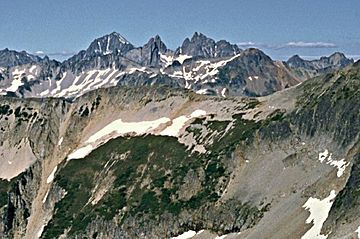Mox Peaks facts for kids
Quick facts for kids Mox Peaks |
|
|---|---|
 |
|
| Highest point | |
| Elevation | 8,504 ft (2,592 m) |
| Prominence | 904 ft (276 m) |
| Geography | |
| Location | Whatcom County, Washington, U.S. |
| Parent range | Cascade Range |
| Topo map | USGS Mount Redoubt |
| Climbing | |
| First ascent | 1941 Fred Beckey |
| Easiest route | SE peak: Grade II class 4-5 NW peak: Grade II-III class 5.5 |
Mox Peaks is a group of mountains in North Cascades National Park in Washington, USA. The highest point of Mox Peaks is about 8,504 feet (2,592 meters) tall. These peaks are found in the northern part of the park. They are very close together and are almost the same height. The eastern peak is the tallest.
Mox Peaks West is near the Redoubt Glacier. It's also at the end of a long, narrow ridge called an arête. This ridge stretches about 1.75 miles (2.8 kilometers) towards Mount Spickard to the northeast. A deep dip in the ridge, called a col, sits between Mox Peaks High Point and Mox Peaks West.
What's the Weather Like?
Mox Peaks is in a special weather area called the marine west coast climate zone. This is found in western North America. Most weather systems start over the Pacific Ocean. They then move northeast towards the Cascade Mountains.
When these weather systems reach the North Cascades, the tall mountains push the air upwards. This makes the air cool down and drop its moisture. This moisture falls as rain or snowfall onto the Cascades. This process is called Orographic lift.
Because of this, the western side of the North Cascades gets a lot of rain and snow. This is especially true during the winter months. In winter, the weather is usually cloudy. However, in summer, high pressure systems over the Pacific Ocean often bring clear skies. The ocean's influence means the snow tends to be wet and heavy. This can lead to a high danger of avalanches.
How the Mountains Were Formed
The North Cascades has some of the roughest land in the Cascade Range. You can see jagged peaks, tall spires, sharp ridges, and deep valleys carved by glaciers. These different landforms and big changes in height create the varied climates. All of this happened because of geological events many years ago.
The Cascade Range started forming millions of years ago. This was during the late Eocene Epoch. At that time, the North American Plate was slowly moving over the Pacific Plate. This movement caused many volcanic eruptions.
Also, small pieces of the Earth's crust, called terranes, joined together. These pieces came from both the ocean floor and continents. This process helped create the North Cascades about 50 million years ago.
During the Pleistocene period, over two million years ago, glaciers moved back and forth many times. As they moved, they scraped away the land. They left behind piles of rock debris. The "U"-shaped valleys you see today were formed by these glaciers. The lifting of the land (called uplift) and cracks in the Earth's crust (called faulting) also played a big role. These forces, along with glaciation, created the tall peaks and deep valleys of the North Cascades.



